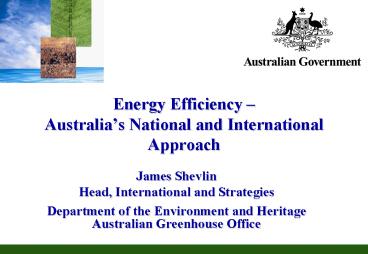Energy Efficiency Australias National and International Approach - PowerPoint PPT Presentation
1 / 9
Title:
Energy Efficiency Australias National and International Approach
Description:
... is a central element of many parts of our mitigation strategy current ... Training and accreditation of energy auditors and energy performance contractors ... – PowerPoint PPT presentation
Number of Views:47
Avg rating:3.0/5.0
Title: Energy Efficiency Australias National and International Approach
1
Energy Efficiency Australias National and
International Approach
- James ShevlinHead, International and Strategies
- Department of the Environment and Heritage
- Australian Greenhouse Office
2
Energy efficiency a core mitigation measure
- Australias mitigation strategy covers all
sectors and include a range of different
approaches, including - Voluntary programs for industry and local
governments - Market measures e.g. tradable renewable energy
certificates - Incentives e.g. competitive abatement grants
- Information for industry and consumers
- Regulatory measures e.g. minimum energy
performance standards - Energy efficiency is a central element of many
parts of our mitigation strategy current
measures are projected to deliver about 40 of
expected energy sector abatement in 2010
3
A win-win opportunity for all
- Energy efficiency offers all countries the
potential to - Reduce energy use - and peak demand
- Reduce greenhouse emissions
- Save money
- Significant untapped potential remains for
example, recent studies indicate that Australia
can - reduce energy use by 3-7 - varies across sectors
- reduce greenhouse emissions by 10 Mt per year
- increase GDP by US750 million a year
- even by implementing only 50 of opportunities
with a payback period of 4 years or less
4
But there are barriers to energy efficiency why
the 20 notes are not always picked up
- Lack of awareness
- Poor understanding of potential
- Lack of clear information including price
signals - Lack of access to necessary expertise or tools
- No internal expertise to identify or implement
opportunities - Perceived risk of new technologies and processes
- Lack of sufficient incentives
- Split incentives - landlords pay costs, tenants
get benefits - Energy efficiency seen as cost rather than an
investment - Energy costs are small component of total costs
for many businesses
5
Increasing the uptake of cost-effective
opportunities key areas and new measures
- Residential and commercial buildings
- Minimum energy performance standards
- Mandatory disclosure of performance
- Commercial/industrial energy efficiency
- Mandatory energy efficiency opportunity
assessments - Training and accreditation of energy auditors and
energy performance contractors - Financial sector
- Increasing awareness and reducing perceived
risk - Standardised evaluation tools
6
Key areas and new measures - continued
- Appliance and equipment energy efficiency
- Minimum standards - to eliminate poor products
- Energy performance labeling to encourage both
purchase and production of better products - Consumer awareness
- Benchmark data on bills
- Government energy efficiency
- Targets and public annual reporting of energy use
- Minimum standards for new buildings and leases
- Solar Cities trials
- Combining renewables, energy efficiency and price
signals
7
Case study Appliance standards and labelling
- Greenhouse reductions of 134 Mt in 2003-2018 at
average savings of 130 per tonne
StandbyPower 2004
Motors
Commercial Refrigeration
Transformers
Lamps Ballasts
Air Con
Appliances 1999
8
Benefits of international cooperation
- Sharing information on opportunities, barriers
and solutions - to inform national approaches
- Access to tools, information resources and
expertise - avoids re-inventing the wheel
- Common performance standards testing
- Reduced costs and improved access to markets and
economies of scale in production of traded goods
9
Bilateral and multilateral cooperation
- Supplying efficient products that meet each
others requirements - China harmonized lighting and testing standards
- NZ common standards and labelling program
- APEC standards for air conditioners and standby
power - Learning from each other
- Fiji Possible adoption of Australian standards
and labelling - EU and USA exchange of information on tools and
approaches































